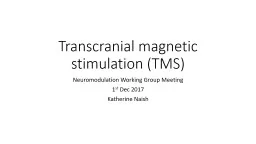

Neuromodulation Working Group Meeting 1 st Dec 2017 Katherine Naish History Thompson 1910 Magnussen amp Stevens 1911 First use of magnetic fields to produce visual phosphenes in early 1900s ID: 779784
Download The PPT/PDF document "Transcranial magnetic stimulation (TMS)" is the property of its rightful owner. Permission is granted to download and print the materials on this web site for personal, non-commercial use only, and to display it on your personal computer provided you do not modify the materials and that you retain all copyright notices contained in the materials. By downloading content from our website, you accept the terms of this agreement.
Slide1
Transcranial magnetic stimulation (TMS)
Neuromodulation Working Group Meeting
1
st
Dec 2017
Katherine Naish
Slide2History
Thompson, 1910
Magnussen & Stevens, 1911
First use of magnetic fields to produce visual phosphenes in early 1900s
Anthony Barker (1985): first use of modern TMS machine
Slide3Mechanism of action
Faraday’s principle of electromagnetic induction: rapid variation in an electrical current can induce a magnetic field
Large magnetic field produced for ~1ms
Rapid change induces electrical current in area under coil, activating neurons
Slide4Types of TMS
Single-pulse TMS (
spTMS
)Paired-pulse TMS (ppTMS)
Repetitive TMS (rTMS)
Slide5Uses of TMS
Single-pulse and paired-pulse used primarily to study the motor system (effects also seen for visual cortex)
Repetitive used to induce longer-lasting changes (therapeutic use) or for disruption of function
Slide6Size of muscle response indicates level of motor activity
(MEP)
Measure of corticospinal excitability
Slide7Disruption of function
https://www.youtube.com/watch?v=gp8KnAHkwdo
Slide8Repetitive TMS (rTMS
)
Repeated pulses over period of seconds or minutes; usually over multiple sessions
Effects last longer than period of stimulationFrequencies above 1Hz usually increase cortical excitability; 1Hz or lower usually decrease excitability
Slide9Repetitive TMS (rTMS
)
Potential mechanism: long term potentiation (LTP) or depression (LTD)
Pharmacological evidence that after-effects involve glutamatergic NMDA receptorCompensatory changes in brain activity
Slide10Important parameters
Stimulation intensity
Pulse frequency
Inter-pulse intervals (e.g., for ppTMS)
Duration of stimulation
Slide11Repetitive TMS (rTMS
)
Therapeutic uses of increasing/decreasing function in certain areas
First therapeutic use for depression, on basis that depression caused by dysfunction in left PFCMore recently,
rTMS used to reduce cravings in substance abuse disorders
Slide12Repetitive TMS (rTMS
)
Considerable within- and between-subject variability
Differences in brain anatomyLevel of attentionHormonal changes
Different effects at different stages of menstrual cycle in women; differences between morning and evening effects